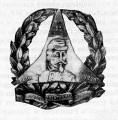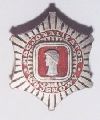
| ORDERS AND DECORATIONS OF POLAND People's Republic of Poland 1944-1989 (Click here to see updates) |
 1.Badge (bronze)
1.Badge (bronze)
(Odznaka Grunwaldzka)
Instituted on July 22, 1945 by the Commander-in-Chief of the Polish Armed Forces. Conferred in two classes: silver (for general ranks) and bronze (for other officers and men) to all soldiers who served directlyin the battle zone. This decoration is a counterpart to the American Combat Infantryman Badge.
Badge:silver or bronze gothic shield, 28 x 54 mm, with two vertical swords pointed down, and an inscription above 1410 : 1945 / GRUNWALD / BERLIN. The whole is surmounted by a non-crowned eagle, sitting on an Amazon shield. The reverse has a mounting screw. The badge is worn on the left chest pocket of the uniform.
 1.Badge
1.Badge(Odznaka Pamiatkowa Dabrowszczakow)
Instituted in 1945 to honor the soldiers of the Jaroslaw Dabrowski XIII International Brigade, which fought on the Republican side during the Spanish civil war of 1936-1939. The brigade composed mostly of Polish volunteers was named in honor of Gen. Jaroslaw Dabrowski (1836-1871) who fell in defense of Paris during the Paris Commune of 1871.
Badge: 35 mm in diameter, made in white metal. The central part has the form of the three-pointed republican star depicting the bust of Gen. Dabrowski. The points of the star there are inscribed XIII / BI : 1936 : 1939. The star is surrounded by a laurel wreath with a scroll containing an inscription in Spanish POR VUESTRA LIBERTAD Y LA NUESTRA (for your liberty and ours). On the reverse there is a mounting screw.
Note 1: most surviving soldiers of the XIII International Brigade were later on awarded with the For Your Liberty and Ours Medal.
Note 2: in 1980 a replica of the decoration in gilt metal was conferred to a few bodies, not necessarily connected with the Spanish civil war, like the General Staff, the Political Academy or the Military History Institute.

 1.Obverse
1.Obverse(Medal Za Udzial w Walkach o Berlin)
Instituted by act of Parliament of April 21, 1966, to commemorate all soldiers of the People's Army who took part in the Berlin Operation in April/May 1945, as well as to other soldiers who were in active service then.The medal was conferred by the Minister of National Defense and it is not regarded therefore as a state but as a ministry decoration. Badge: silver medal 38 mm of diameter. Obverse: a likeness of the Order of the Grunwald Cross, circumscribed by the inscription ZA UDZIAL : W WALKACH O BERLIN (for participation in the battle of Berlin). The reverse bears a stylized vertical laurel spray with an inscription MINISTERSTWO / OBRONY NARODOWEJ /PRL (Ministry of National Defense People's Republic of Poland) superimposed on it.
Ribbon: 40 mm, red with black (inner) and yellow (outer) side stripes.

 1.Obverse, [Reverse]
1.Obverse, [Reverse](Odznaka "Zasluzony Funkcjonariusz Pozarnictwa")
Instituted by decision of Minister of the Interior of February 27, 1984, to honor members of professional Fire Service in recognition of merit and long meritorious service. The decoration had one grade and could be conferred once only. It was confered by the Minister of the Interior at the suggestion of the Chief Commandant of the Professional Fire Service. Its conferment was suspended ca. at the beginning of 1990s.
Badge: bronze round medal, 37 mm of diameter. Obverse: a fireman's head in a helmet on the background of a Polish uncrowned eagle, surrounded by a laurel spray on the left and oak spray on the right. The ring bears the circumscription: ZASLUZONY FUNKCJONARIUSZ POZARNICTWA . Reverse: a three line inscription MINISTERSTWO / SPRAW / WEWNETRZNYCH (Ministry of the Interior).
Ribbon: 37 mm, dark blue with dark red edges 10 mm each.
![]()

 1.Obverse (silver)
1.Obverse (silver)(Medal "Za Zaslugi w Ochronie Porzadku Publicznego")
Instituted by decision of the Government of October 15, 1971, to honor the individuals who contributed to maintenance of public order or showed bravery and sacrifice or distinguished themselves in performing the duties to maintain public order. Conferred in three grades: gold, silver and bronze by the prime minister at the suggestion of the minister of the interior. It could be conferred to institutions and organizations as well. The medal was meant primarily for members of the Civic Militia (equivalent to police forces in other countries) and Security Service. Not conferred since 1990.
Badge: round medal, 32 mm of diameter. Obverse: a Gothic shield with a Polish eagle, superimposed on a stylized rosette. Reverse: inscribed ZA ZASLUGI / W OCHRONIE / PORZADKU / PUBLICZNEGO (for merit in maintenance of public order), with an oak spray above and below, and the letters PRL at the bottom.
Ribbon: 37 mm, blue with a wide red central stripe and narrower white side stripes.




 1.Obverse (gold)
1.Obverse (gold)(Odznaka "Za zaslugi w Ochronie Granic PRL")
Instituted by decision of the Government of June 6, 1975 to reward those soldiers and civilian workers of the Frontier Guards who contributed to protection of state frontier. The decoration was conferred by Minister of the Interior. It could be conferred to Frontier Guards units, institutions and organizations. It had three grades: gold, silver and bronze.
Badge: round medal, 33 mm of diameter. Obverse: a contour of Poland with an unrowned eagle inside and eight frontier poles extending radially from it. Reverse: a Gothic shield superimposed on a sword pointing down, and surrounded by two laurel sprays. Inside the shield there is a seven line inscription: ZA ZASLUGI / W OCHRONIE / GRANIC / POLSKIEJ / RZECZYPO / SPOLITEJ / LUDOWEJ (for merit in protection of state frontier of the People's Republic of Poland).
Ribbon: 35 mm, dark green with white (inner) and red (outer) edges.
![]()
![]()
![]()

 1.Obverse (gold) [silver]
1.Obverse (gold) [silver](Odznaka "W Sluzbie Narodu")
Instituted by decision of the Government of May 12, 1974, for long service in the Civic Militia and Security Service. Conferred by Minister of the Interior in three grades: gold, silver and bronze, for 30, 20 and 10 year service respectively. The decoration replaced two previously conferred ones: "20 Years in Service for the Nation" (Dwadziescia Lat w Sluzbie Narodu -- instituted ) and "10 Years in Service for the Nation" (Dziesiec Lat w Sluzbie Narodu -- instituted ), both worn on the right breas pocket.
Badge: round medal, 32 mm of diameter. Obverse: an uncrowned Polish eagle superimpised on a sword pointed down, and surrounded by an open oak wreath with the inscription: W SLUZBIE NARODU: Below there is a shield with the Roman numerals "XXX", "XX" and "X" respectively. Reverse: letters "MSW" (Ministerstwo Spraw Wewnetrznych -- Ministry of the Interior), with stylized laurel sprays above and below, all circumscribed POLSKA RZECZPOSPOLITA LUDOWA (People's Republic of Poland).
Ribbon: 37 mm, blue with red (inner) and white (outer) edge stripes.
![]()
![]()
![]()


 1.Obverse (gold)
1.Obverse (gold)(Odznaka "Na Strazy Pokoju")
Instituted by decision of the Government of September 22, 1972, primarily as a form of recognition for the officers and soldiers of the Soviet Army stationed on the territory of Poland. In exceptional cases the decoration could be conferred to other people as well. The decoration had three grades: gold, silver and bronze. It was conferred by the Prime Minister of Poland. Not awarded since 1990.
Badge: round medal, 38 mm of diameter. Obverse: contour of Poland with a stylized eagle inside, the words BALTYK (Baltic) above and ODRA NYSA (Oder, Neisse) below, and a frontier pole on the left. The medal is encircled by a ring with the inscription: NA STRAZY : POKOJU. Reverse: a five line iscription RADA / MINISTROW / POLSKIEJ / RZECZYPOLITEJ / LUDOWEJ (Government of the People's Republic of Poland) in the center and circumscription PRZYJAZN SOCJALIZM POKOJ (friendship, socialism, peace) in a ring around.
Ribbon: of two stripes of equal width - dark red on the left and half white half red on the right, separated by a narrow green stripe in the center and narrow green edges.
![]()
![]()
![]()

 1.Decoration until 1975 [reverse]
1.Decoration until 1975 [reverse](Odznaka Braterstwa Broni)
Instituted by decision of the Government of October 7, 1963. Conferred in a single grade as a symbol of recognition for members of the armed forces of the USSR and other countries under its domination.
Badge: round silver medal, 30 mm of diameter. Obverse: the image of the Grunwald Badge, slightly protruding from the medal, and superimposed on a contour of Poland. The medal has a ring circumscribed BRATERSTWO BRONI NA STRAZY POKOJU I SOCJALIZMU (brotherhood in arms on the guard of peace and socialism). Reverse: a three line inscription MINISTERSTWO / OBRONY / NARODOWEJ (Ministry of National Defense), circumscribed POLSKA RZECZPOSPOLITA : LUDOWA (People's Republic of Poland).
Suspension: originally with a silver frame with a ribbon bar, mounted to the uniform with a safety pin.; from 1975 -- a normal ribbon, linked to the medal with two narrow chains and a suspension ring.
Ribbon: 30 mm, claret with three narrow white stripes.
![]()

 1.Gold (with suspension)
1.Gold (with suspension)(Odznaka "Zasluzony Racjonalizator Wojskowy")
(Odznaka "Racjonalizator Wojskowy")
Instituted by decision of Minister of National Defense of June 5, 1971. Conferred to the military in two grades. The silver grade was conferred by Chef Inspector of Planning and Technology to those individuals who had presented three rationalizing projects, while the gold grade (Meritorious Military Rationalizer Decoration) is awarded by Minister of National Defense for at least five projects.
Badge: gold or silver six pointed star, 36 mm of diameter. In the center there is a square red enameled shield with a soldier's head facing left. A red enameled ring bears the inscription: RACJONALIZATOR : WOJSKOWY (military rationalizer.). Reverse: plain.
Suspension: originally mounted to the right breast pocket of the uniform with the screw; later suspended from a red enameled bar 36 x 8 mm, with green edges (3 mm) and worn on the right breast.
Ribbon: similar to the suspension.



 1.Obverse (gold)
1.Obverse (gold)(Odznaka Wojsk Lotniczych za Osiagniecia w Dzialalnosci Racjonalizatorskiej-Nowatorskiej) Instituted 1977. Conferred by the Air Force Comand in two classes: gold and silver, to members of the air force who had introduced a technological project or projects to improve combat readiness of the air force. In exceptional cases the decoration could be confered to non-members of the air force.
Badge: round medal, 30mm of diameter. Obverse: light blue enameled with golden, silver and bronze plain rays. In the center there is a white and red enameled chessboard - the emblem of the Polish Air Force. Reverse: a three line inscription in small block letters: DOWODZTWO / WOJSK / LOTNICZYCH (air force command) and a five line inscription: ZA / OSIAGNIECIA / W DZIALALNOSCI / RACJONALIZATOR- / SKIEJ-NOWA- / TORSKIEJ (for achievement in rationalizing-improvement activities).
Suspension: light blue enameled rectangular bar, 30 x 8 mm, with a narrow white-red horizontal stripe.
Ribbon (unofficial): 35 mm, similar to the suspension.
![]()
![]()